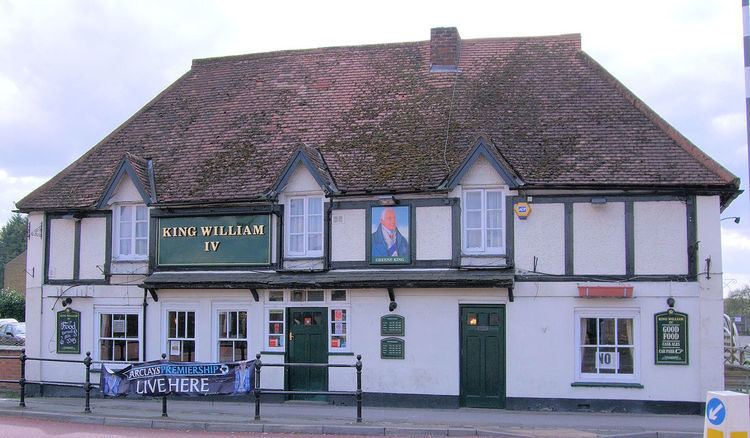OS grid reference TQ075785 Sovereign state United Kingdom Local time Wednesday 9:29 PM | Postcode district UB7 Dialling code 020 Post town West Drayton | |
 | ||
Weather 6°C, Wind SE at 6 km/h, 87% Humidity | ||
Sipson is a village in the historic county of Middlesex, England, but since 1965 has been administered as part of the London Borough of Hillingdon, the westernmost borough of Greater London. It is 14.3 miles (23 km) west of Charing Cross and near the north perimeter of London Heathrow Airport.
Contents
- Map of Sipson UK
- Toponymy
- Heathrow expansion
- Sipson Farm
- Wall Garden Farm
- King William IV pub
- Excavating gravel
- Other history
- Notable people
- References
Map of Sipson, UK
Toponymy
The village's name comes from the Anglo-Saxon Sibbwines tūn: "Sibbwine's farmstead". Sipson village adjoins the famous "Bath Road" (the modern A4), which linked London to Bath.
Heathrow expansion
On 10 January 1946 the British Cabinet agreed Stage 3 of the airport, which was an extension north of the Bath Road, with a large triangle of 3 runways, obliterating Sipson and most of Harlington, and diverting the Bath Road.
In 2009 the majority of the village was under threat of demolition owing to the planned expansion of London Heathrow Airport, which would have created a third runway at the airport. However, in March 2010 in accordance with multilateral environmental regulations and evidence that gas pollutant thresholds would be further breached within the wider area the English High Court of Justice ruled that the plan which the Department had submitted must be reconsidered. Accordingly, the Government announced in May 2010 that the third runway plan had been cancelled but that a long-term study into airport capacity in the South East and beyond may recommend expansion to any of the London Airports where the environmental constraints can all be met. Since 2009 BAA have been acquiring property in Sipson and elsewhere when advertised for sale which means there will be fewer resident owners to oppose further plans for expansion with a third runway. Contrary to this movement, opponents such as actress Emma Thompson and various others have bought land within the boundaries in 2009 with a view to preventing such expansion. In addition to this there has been a long term occupation of land within Sipson by climate activists on the invitation of local residents, following the latest Climate Camp. Grow Heathrow is a squatted community, opposed to the expansion of Heathrow airport and committed to finding sustainable alternatives in the face of climate change, peak oil and economic crises. Further, local residents have started a new campaign in 2014 called Stop Heathrow Expansion, with widespread support from local MPs and Councillors.
Sipson Farm
Sipson Farm was in the northeast angle of the Sipson crossroads. It was the biggest farm in the area. It had a big area of greenhouses. It had 500 acres of land in Harmondsworth and Sipson and Harlington and Heathrow. In 1900 it had a big area of fruit orchard.
Wall Garden Farm
Wall Garden Farm is a little east of the Sipson crossroads, north of the road to Harlington. It was orchard land, surrounded and divided by high walls to keep winds and frost (and fruit thieves) off.
King William IV pub
The King William IV public house at the Sipson crossroads was built in the 16th century, and later altered, including a refronting in the 1930s. Originally a Wealden-type mediaeval hall house, it is a Grade II listed building.
Excavating gravel
Gravel companies own much land in Harmondsworth and Sipson and Harlington. They get planning permission to extract gravel and sand on condition that they restore the land for agriculture afterwards. Their land is used for growing wheat before and after gravel extracting.
